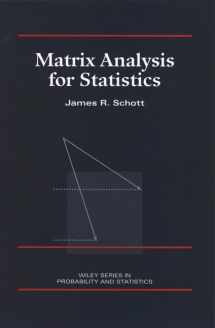
Matrix Analyis for Statistics (Wiley Series in Probability and Statistics)
Book details
Summary
Description
A complete, self-contained introduction to matrix analysis theory and practice
Matrix methods have evolved from a tool for expressing statistical problems to an indispensable part of the development, understanding, and use of various types of complex statistical analyses. As such, they have become a vital part of any statistical education. Unfortunately, matrix methods are usually treated piecemeal in courses on everything from regression analysis to stochastic processes. Matrix Analysis for Statistics offers a unique view of matrix analysis theory and methods as a whole.
Professor James R. Schott provides in-depth, step-by-step coverage of the most common matrix methods now used in statistical applications, including eigenvalues and eigenvectors, the Moore-Penrose inverse, matrix differentiation, the distribution of quadratic forms, and more. The subject matter is presented in a theorem/proof format, and every effort has been made to ease the transition from one topic to another. Proofs are easy to follow, and the author carefully justifies every step. Accessible even for readers with a cursory background in statistics, the text uses examples that are familiar and easy to understand. Other key features that make this the ideal introduction to matrix analysis theory and practice include:
- Self-contained chapters for flexibility in topic choice.
- Extensive examples and chapter-end practice exercises.
- Optional sections for mathematically advanced readers.


We would LOVE it if you could help us and other readers by reviewing the book
Book review



